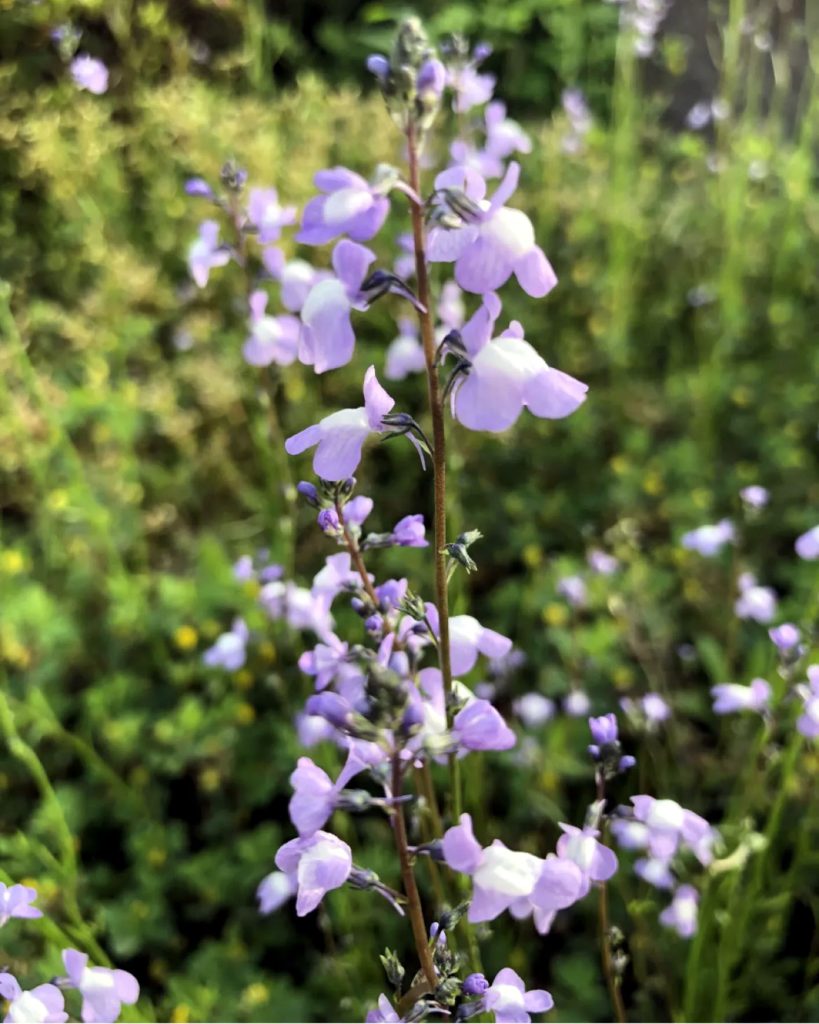
When the cherry blossoms have finished and the wisteria flowers are past their peak, you may see purple flowers blooming in abundance along the edges of farm roads, creating a landscape that looks as if it is covered in a light purple haze. These are Matsuba-unran (pine-leaved toadflax. From now until early summer, they will grow stems about 30-50 cm tall from the ground, with numerous light purple flowers blooming at the tips of the branched stems. Matsubaunran is not a plant that has long been native to Japan; it is an introduced species that came from overseas. Its origin is North America, and the first record of it being collected in Japan was in 1941 in the Mukōjima area of Fushimi Ward, Kyoto. Since then, it has rapidly spread nationwide and can now be seen throughout Japan except for Hokkaido. Because its flowers resemble those of the native coastal plant Unran (Linaria japonica) and its leaves are as thin as pine needles, it came to be called Matsuba-unran. The most notable feature of Matsuba-unran is its strong reproductive ability, allowing it to spread quickly. Although the flowers are cute in appearance, it is often treated as a weed. The flowers are very small, about 1 cm, and the plant’s height ranges from 30 cm to 50 cm. Its slender appearance sways gracefully in the wind, making it quite striking. Recently, more people are planting it in their gardens for ornamental purposes, but if it takes root in the garden, it can become difficult to remove.
サクラの花も終わり、フジの花も盛りを過ぎた頃、農道の脇に紫色の花がいっせいに咲き、あたかも淡い紫色の霞がかかったような風景をつくることがあります。マツバウンラン(松葉海蘭)です。これから初夏にかけて高さ30~50cmほどの茎を地表から立ち上げて、枝分かれしたそれぞれの先端に淡い紫色の花を多数咲かせます。マツバウンランは古くから日本に自生していた植物ではなく、海外から日本へやってきた帰化植物です。原産地は北アメリカで、1941年に京都市伏見区向島で採集された記録が最初とされています。それから急速に全国に広がり、今では、北海道を除く日本全域で見られる様になりました。古くから日本の海岸に自生しているウンラン(海蘭)の花に似ていることと、葉が松葉の様に細いことからマツバウンランと呼ばれる様になりました。マツバウンランの最大の特徴は、繁殖力が強く、あっという間に広がるので、花の見た目はかわいいですが、雑草として扱われることが多い植物です。花はとても小さく1cmほどで、草丈は30cmから50cmほどと、すらっとしていて風でユラユラとする姿が印象的です。最近は観賞用とし庭に植え込む向きも増えていますが、庭に入り込むと、駆除が面倒になることがあります。
